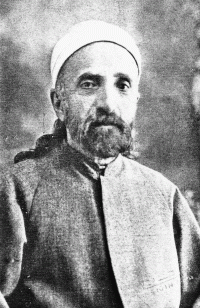Mírzá Muhammad ʻAlí
Mírzá Muhammad ʻAlí | |
|---|---|
 | |
| Born | December 16, 1853 |
| Died | 10 December 1937 (aged 83) |
| Children | Shua Ullah Behai Amin Ullah Bahai Mousa (Musa) Bahai |
| Parents |
|
Mírzá Muhammad ʻAlí (
| Part of a series on the |
| Baháʼí Faith |
|---|
 |
Early years
Mírzá Muhammad ʻAlí was born on December 16, 1853, in Baghdad during Baháʼu'lláh's first year of exile in that city. In 1863, at the age of nine, he accompanied his family in their exile to Constantinople and Adrianople. During the final days in Adrianople, Mírzá Muhammad ʻAlí wrote about eighty letters to the believers of the Baháʼí Faith, such as those in Baghdad and its surrounding towns. He also asked permission of his father to travel abroad and spread the Baháʼí Faith.[citation needed]
Dispute with ʻAbdu'l-Bahá
In the
At the time of ʻAbdu'l-Bahá's death,
The division between rival sects with Mírzá Muhammad ʻAlí and Shoghi Effendi as their respective leaders was short-lived and Shoghi Effendi emerged as the leader of the global Baháʼí community, labeling Muhammad ʻAlí the arch-breaker of the Covenant of Baháʼu'lláh.[6] Mírzá Muhammad ʻAlí would lead the small Unitarian Baha'i denomination. In 1904, he sent his oldest son, Shua Ullah Behai, to the United States where he led the Unitarian Baha'i community. From 1934 to 1937, Behai published Behai Quarterly,[7] a Unitarian Baháʼí magazine written in English and featuring the writings of Mirza Muhammad ʻAlí and various other Unitarian Bahais, including Ibrahim George Kheiralla.[8] This schism had very little effect overall. In the ʻAkká area, the followers of Muhammad ʻAlí represented six families at most, they had no common religious activities,[8] and were almost wholly assimilated into Muslim society.[9] This group essentially disappeared.[10][11][12] A modern academic observer [clarification needed] has reported an ineffectual attempt to revive the claims of Muhammad Ali.[13]

Death
Mirza Muhammad ʻAlí died on December 10, 1937, in the city of Haifa in the Mandate of Palestine. Memorial services were held at Haifa on Tuesday, January the 18th, 1938.[citation needed]
See also
- Baháʼu'lláh's family
- Covenant-breaker
- Baháʼí divisions
Notes
- superlative or a comparative. G͟husn-i-Akbar could mean "Greatest Branch" or "Greater Branch."
References
- ^ Taherzadeh 2000, p. 256
- ^ Baháʼu'lláh 1994, pp. 221–222
- ^ Baháʼu'lláh 1994, Kitáb-i-ʻAhd.
- ^ Taherzadeh 2000, p. 44
- ISBN 978-0877433736.
- ^ Adamson 2009, p. 121
- ^ Cole, Juan R.I.; Quinn, Sholeh; Smith, Peter; Walbridge, John, eds. (July 2004). "Behai Quarterly". Documents on the Shaykhi, Babi and Baha'i Movements. 08 (2). h-net.msu.edu. Retrieved October 15, 2016.
- ^ ISBN 1-56085-169-4. Archived from the originalon 2013-02-02.
- ^ MacEoin, Denis. "Bahai and Babi Schisms". Encyclopædia Iranica.
In Palestine, the followers of Moḥammad-ʿAlī continued as a small group of families opposed to the Bahai leadership in Haifa; they have now been almost wholly re-assimilated into Muslim society.
- ISBN 0-304-35592-5.
- ^ MacEoin, Denis. "Bahai and Babi Schisms". Encyclopædia Iranica.
Other small groups have broken away from the main body from time to time, but none of these has attracted a sizeable following.
- ISBN 1-85168-184-1. Quote from source: "After the death of Shoghi Effendi (1957) the only significant oppositional movement was that led by … C. M. Remey…. The movement subsequently splintered…."
- ^ McGlinn, Sen (March 27, 2010). "A Muhammad Ali revival?". Retrieved 2010-04-17.
References
- ISBN 978-0877433736.
- Adamson, Hugh C. (2009). The A to Z of the Baha'i Faith. Rowman & Littlefield. ISBN 978-0810868533.
- ISBN 0-87743-174-4.
- Momen, Moojan (2003). "The Covenant and Covenant-Breaker". bahai-library.com. Retrieved October 13, 2016.
- ISBN 0-85398-439-5.
- ISBN 1-85168-184-1.
- ISBN 0-85398-344-5.

